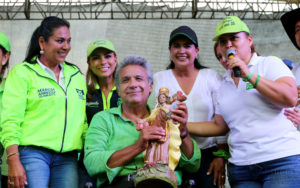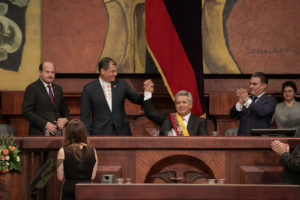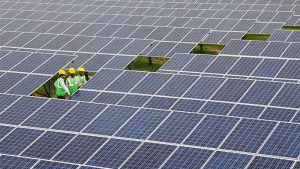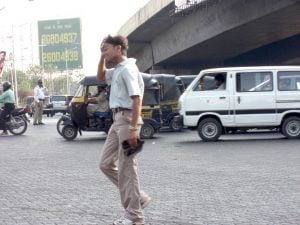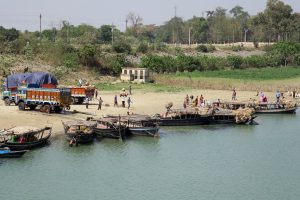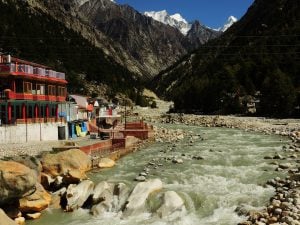Ecuador is experiencing an electoral conflict between two different government models, both of which aim to generate employment and protect the country from the effects of the international economic crisis.
On the one hand, Lenín Moreno from the incumbent Alianza País (Country Alliance) party, defends the state-led social welfare model which was established during the last decade by the Rafael Correa government. On the other, Guillermo Lasso of Creando Oportunidades (Creating Opportunities, CREO), proposes a corporate-business model.
Both candidates have expressed their interest in continuing relations with China, but in different ways.
Implications for China-Ecuador relations
Neither candidate can afford to ignore two factors at the international level, which have big implications for development around the world; the rise of China and the economic crisis. It is clear that both candidates are fully aware of China’s growing role in international affairs, as stated in the specific references in their plans for government.
China has become a central protagonist in the process of globalisation by making itself into the factory of the world. This was interpreted in Latin America as an opportunity to acquire consumer goods at low prices, but also to gain access to the largest market in the world and a major source of investment and financing for development. China is Ecuador’s principal financial partner. According to official sources, debt to China accounts for approximately 30% of the country’s total debt.
Since the 2008 financial crisis, trade at the global level has experienced a downward trend, accompanied by the end of the commodities cycle. The latter is due in part to the fall in Chinese demand for primary products, which has strongly impacted commodity-exporting countries in the Latin America region. In the area of finance for development, a slowdown has been experienced because of the downturn in economic growth in industrialised countries and a rise in interest rates in the US. As a result, there has been a reduction in global flows of Foreign Direct Investment (FDI).
The impact of the crisis in Latin America has been felt heavily in production and trade, causing heavy erosion of the social fabric of the countries in the region. In Ecuador’s case, there are at least five additional factors that have aggravated the situation; the downward trend in oil prices, a payment of approximately US$1 billion to OXY and Chevron in 2016, a decline in tax collection, the April 2016 earthquake with reconstruction costing approximately two billion dollars, and the devaluation of the currencies of neighbouring countries. With this in mind, Ecuador should maintain a foreign policy prioritising those exchanges that allow it to consolidate change in its productive and energy fields.
China’s influence in Latin America and the Caribbean
So far, relations with China have been mutually beneficial in some respects, but they could be improved. China faces great challenges that force it to turn its eyes towards the countries of the region. According to the Economic Commission for Latin American and the Caribbean (ECLAC), the Asian country has 1.3 billion inhabitants, but only 7% of the arable land in the world. For these reasons, Latin America is an important market for the Asian country, not only as a source of extractive resources, but also since it has the potential to expand its exports of agricultural products. However, China has become a strategic partner for the promotion of development projects in countries like Venezuela, Ecuador and Argentina.
These countries have been the recipients of Chinese investment in the development of infrastructure for the exploitation of natural resources (refineries, hydroelectric, etc.), transport, health and education, among others. But not everything is rosy. These have brought about environmental and economic problems, such as the large external debt that countries like Ecuador maintain with China.
Contrasting proposals
Moreno shares Xi Jinping’s vision regarding the need to consolidate a ‘multi-polar’ international system. In his government plan, the Alianza País candidate maintains that Latin America should unite as a bloc, thus deepening relations with China and Russia, countries which share its theory on the democratisation of the international system. Moreno also proposes the promotion of his reform of the international financial system, in particular his proposal on tax havens, under the auspices of the Group of 77 (G77) + China. Lasso does not have a specific agenda to advance within this international body.
In the trade arena, Lasso talks about entering into free trade agreements with the United States, China, India and Japan, together with Latin American regional bloc the Pacific Alliance, while Moreno proposes the strengthening of intra-regional trade relations, and South-South trade relations.
In the area of finance and investment, Moreno proposes expanding on existing relations with China in the tourism, agribusiness, technology and financing sectors. Lasso, on the other hand, has not expressed an intention to strengthen relations with China beyond trade. The CREO candidate does, however, propose to bring greater transparency to credit agreements set up by the current government, most of them with China. Finally, both candidates propose restructuring external debt. According to Lenín Moreno, China has demonstrated willingness in this regard.
It seems that Sino-Ecuadorian relations would have a greater profile extending into more areas under a Lenín Moreno, as opposed to a Guillermo Lasso government. This would be driven by the ideological orientation of the Alianza País candidate, not necessarily by China, whose president Xi Jinping has declared willingness to work with Latin American partners irrespective of their ideological inclination. Trade, finance and investment would likely remain largely unchanged under either. Both Lasso and Moreno mention the importance of diversifying their business and financial partners. However, for the CREO party candidate, rapprochement with the US seems to be one of the main goals.
China has shown a strong interest in strengthening its relations with Ecuador, as shown by President Xi Jinping’s visit to Ecuador in 2016. The relationship with China continues to have asymmetries that work in favour of the Asian country, which is why it is important for the new Ecuadorian leader to seek to promote the construction of a regional bloc, which would allow him to negotiate under better conditions. Moreno’s government plan points in this direction. Lasso has not considered a way of strengthening the region to act as a bloc against the rest of the world. China is an important ally, but to harness the potential of this relationship, it requires a leader with a long-term strategic perspective, not one who is anxious to rush through deals and maximise it.
